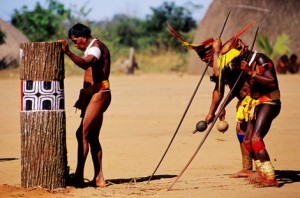
Xingu River Basin Indians celebrating Kuarap — Image courtesy of http://brazilinhotpants.wordpress.com/
While we revelers in the U.S. fan out to solicit candy and purchase alcoholic beverages, celebrating a holiday whose commercialism has almost become a parody of itself, perhaps we would do well to look a little further south, to the still-surviving Native American tribes of the Amazon. In the days-long ceremony of Kuarap, the Indian tribes of the Xingu river basin deep in the rain forest, thoroughly insulated from the encroachment of modernity, come together to celebrate death with life. But while Kuarap is known first and foremost as a funereal ceremony, it is also a joyous occasion of laughter, feasts, athletic competition, music and flirtation. It is a chance to reinforce inter-tribal alliances, to re-tell ancient Native American Amazon myths of creation, and to initiate young women into adult tribal society. In essence, the entire cycle of life is re-created in this festival whose genesis is death, but which, in the telling of the Xingu Indians, cannot be approached without all of the rest of it as well.
The festival begins with a night of weeping and lamenting, meant to invoke the spirits of the dead. Wooden logs are decorated with cloth and feathers to represent those who have passed, and to remind the living of death’s irreversibility. Revelers weep over these logs through the night, and the logs are later awarded to winners of the huka-huka wrestling matches, where representatives of the different villages square off in brief, ferocious non-lethal combat. After the wrestling matches, the young girls formerly isolated from the village while they were going through puberty, offer pequi seeds to the chiefs of each village, and their ritual uluri belts are removed. A feast follows, and then the Ritual of the Flutes, in which tribesmen play giant uruá flutes and dance in pairs with the young girls, throughout the village and into the evening. The Kuarap ends with a traditional goodbye to the invited tribal representatives on behalf of the hosts. In this way, the entire cycle of life has been re-created, from death, to re-birth, to life and combat, to the sad farewell until their paths cross again, hopefully under like joyful circumstances.
The ceremony of Kuarap that celebrates death with life goes back centuries, and has survived assault by European slavers, disease, poachers, loggers and hunters. Driven back from their home regions further down the river, the Xingu Indian tribes that endure today, with about 30 settlements and over 3,000 inhabitants, have fiercely defended and maintained their traditions. At one point in the 1950s, it was estimated that only 500 Xingus still survived. Since that time, and thanks in part to the enterprising advocacy of certain segments of Brazilian society, most notably the Villas-Bôas Brothers, the Xingu region was classified as a national park, and vigorously defended, and the tribes have regained some of their former strength. And even today, the Kuarap festival is still a sight to see.

 The Xingu Indian Kuarap Festival Celebrates Death with Life
The Xingu Indian Kuarap Festival Celebrates Death with Life



 “In Case You Don’t Live Forever” by Ben Platt
“In Case You Don’t Live Forever” by Ben Platt
 Our Monthly Tip: Make an “In Case of Death” File to Ease Loved One’s Grief
Our Monthly Tip: Make an “In Case of Death” File to Ease Loved One’s Grief
 Passing of Beloved Comedian Births a New Comedy Festival
Passing of Beloved Comedian Births a New Comedy Festival














